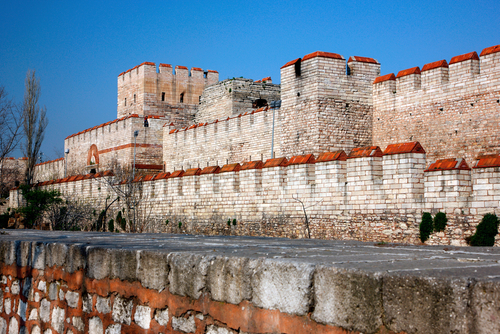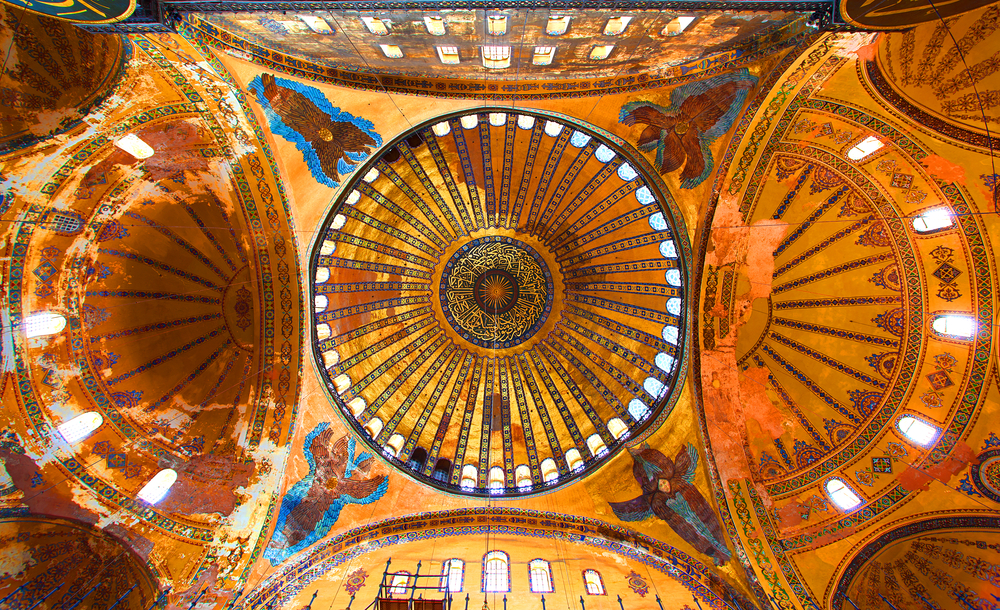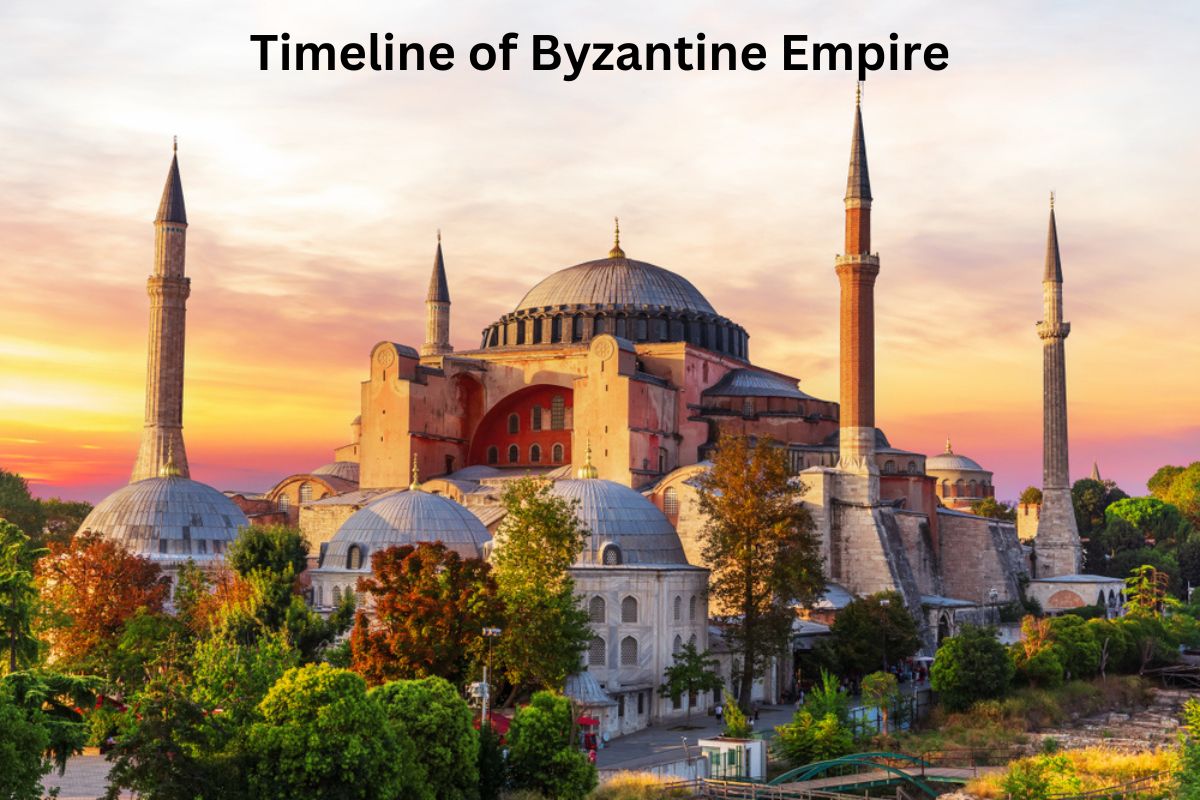The Byzantine Empire, also known as the Eastern Roman Empire, was a continuation of the Roman Empire in its eastern provinces during Late Antiquity and the Middle Ages, when its capital city was Constantinople (modern-day Istanbul, originally founded as Byzantium).
It survived the fragmentation and fall of the Western Roman Empire in the 5th century AD and continued to exist for an additional thousand years until it fell to the Ottoman Turks in 1453.
Throughout most of its existence, the Byzantine Empire was the most powerful economic, cultural, and military force in Europe. Its heritage, largely Greek and Christian, would influence the Renaissance in Western Europe.
Byzantine art, music, and literature have greatly shaped world culture, and its architectural works, like the Hagia Sophia and the city walls of Constantinople, are world-renowned even today.
Also Read: Byzantine Empire Accomplishments
Despite the cultural and historical continuity, the Byzantine Empire underwent significant transformations over the centuries, facing periods of great strength and crippling weakness, managing a complex relationship with the Western European powers, navigating religious schisms, and coping with both internal strife and external threats.
| Year(s) | Event |
|---|---|
| 330 AD | Constantine the Great moves the Roman capital to Byzantium, renaming it Constantinople, marking the foundation of the Byzantine Empire |
| 395 AD | The Roman Empire officially splits into the Western Roman Empire and the Eastern Roman Empire (Byzantine Empire) after the death of Theodosius I |
| 476 AD | The fall of the Western Roman Empire leaves the Byzantine Empire as the continuation of the original Roman state |
| 527-565 AD | The reign of Justinian I, notable for the Justinian Code, reconquest of much of the Western Mediterranean, and the construction of the Hagia Sophia |
| 610-641 AD | The reign of Heraclius, during which the Empire’s military and administrative structures were significantly reformed |
| 634-718 AD | The Arab–Byzantine wars result in significant territorial loss for the Byzantine Empire |
| 800 AD | Charlemagne is crowned “Emperor of the Romans” by Pope Leo III, leading to disputes over the legitimacy of the Byzantine Empire |
| 867-1056 AD | The prosperous reign of the Macedonian dynasty, marking a period of revival for the Byzantine Empire |
| 1054 AD | The Great Schism occurs between the Western (Roman Catholic) and Eastern (Orthodox) Christian Churches |
| 1071 AD | The Byzantine Empire suffers a major defeat against the Seljuk Turks at the Battle of Manzikert, leading to the loss of much of Anatolia |
| 1204 AD | The Fourth Crusade captures Constantinople and establishes the Latin Empire. The Byzantine Empire splinters into several small states |
| 1261 AD | The Byzantine Empire is restored under the Palaiologos dynasty with Michael VIII Palaiologos recapturing Constantinople from the Latin Empire |
| 1453 AD | The Fall of Constantinople to the Ottoman Turks and the death of Emperor Constantine XI Palaiologos mark the end of the Byzantine Empire |
Byzantine Empire Timeline
330 AD – Foundation of the Byzantine Empire with the establishment of Constantinople
Emperor Constantine I, also known as Constantine the Great, moved the capital of the Roman Empire from Rome to the ancient city of Byzantium, which he renamed as Constantinople (now Istanbul, Turkey).

The city was strategically placed to control traffic between Europe and Asia, and was easier to defend than Rome. This move marked the beginning of the Eastern Roman Empire, later known as the Byzantine Empire.
Also Read: Byzantine Empire Facts
Constantine also made Christianity the official religion, which deeply influenced Byzantine culture and laws.
395 AD – Split of the Roman Empire into Western and Eastern Roman Empires
After the death of Theodosius I, the last Emperor to rule over a unified Roman Empire, the state was divided into two: the Western Roman Empire, with Rome as its capital, and the Eastern Roman Empire (the Byzantine Empire), with Constantinople as its capital.
The Western and Eastern empires operated independently, each with its own emperor and administrative apparatus.
476 AD – Fall of the Western Roman Empire
The Western Roman Empire fell to a coalition of Germanic tribes, marking the end of ancient Rome’s influence in the west. However, the Eastern Roman Empire (Byzantine Empire) survived and became a powerful state.
With the fall of the Western Roman Empire, the Byzantine Empire considered itself the continuation of the Roman state and preserved much of its laws, customs, and administrative structures.
527-565 AD – Reign of Justinian I, marked by significant achievements
Justinian I, also known as Justinian the Great, was one of the most significant Byzantine emperors.
His reign was marked by ambitious building projects, including the reconstruction of the Hagia Sophia, and the codification of Roman laws in what came to be known as the Justinian Code.
He also undertook military campaigns to recapture parts of the former Western Roman Empire, including Italy and parts of North Africa.

610-641 AD – Heraclius’ reign and important administrative reforms
Heraclius was another significant Byzantine emperor. He carried out important military reforms, reorganizing the empire’s provinces into themes to counter external threats, particularly from the Persians.
He also replaced Latin with Greek as the official language of the empire. Heraclius’ reign was dominated by wars with the Sassanid Persian Empire, which he initially successfully countered, but then faced new threats from the Arab Muslims, who started to rise in power towards the end of his reign.
634-718 AD – Arab–Byzantine wars leading to significant territorial losses
During this time, the Byzantine Empire was engaged in a series of wars with the newly formed Arab Caliphate.
The rise of Islam in the 7th century led to the Muslim Arab forces’ expansion, and they rapidly took over territories that were part of the Byzantine Empire, including Syria, Palestine, Egypt and eventually North Africa.
These territories were significant as they were prosperous regions and key to the Eastern Mediterranean’s trade networks.
Despite these losses, the Byzantine Empire was able to hold onto its Anatolian heartland and maintained its capital at Constantinople, which repelled two major Arab sieges in 674-678 and 717-718.
800 AD – Coronation of Charlemagne, creating disputes over the Roman imperial title
On Christmas Day, Charlemagne, the King of the Franks and Lombards, was crowned as “Emperor of the Romans” by Pope Leo III in Rome.
It was highly controversial as it implied that the throne of the Roman Empire was vacant, dismissing the claim of the Byzantine Empire as the legitimate Roman Empire.
This event exacerbated the growing cultural, religious, and political differences between the Eastern and Western parts of what was once the unified Roman Empire, and it played a significant role in the development of the Holy Roman Empire in the West.
867-1056 AD – Reign of the Macedonian dynasty, a period of prosperity and revival
The Macedonian Dynasty is considered one of the high points of the Byzantine Empire. Founded by Basil I, the dynasty oversaw a period of territorial expansion, increased diplomatic prestige, and cultural flourishing, often referred to as the “Macedonian Renaissance.”
This period also saw the creation of the Byzantine thematic military system and the reduction of Arab raiding, allowing the Byzantine Empire to project power across its borders effectively.
1054 AD – The Great Schism, dividing Western and Eastern Christianity
The Great Schism marked the formal split of Christianity into two branches: the Roman Catholic Church in the West and the Orthodox Church in the East. The split was the culmination of theological, cultural, and political disagreements that had developed over centuries.
Some of the critical issues were disputes over papal authority—the Pope claimed he held authority over the four Eastern patriarchs—and the source of the Holy Spirit. The schism weakened the religious unity of the empire and had lasting religious and geopolitical effects.
1071 AD – Defeat at the Battle of Manzikert against the Seljuk Turks
The Battle of Manzikert was a decisive conflict between the Byzantine Empire and the Seljuk Turks. The battle was a catastrophic defeat for the Byzantines, resulting in the capture of the Emperor Romanos IV Diogenes.
This marked the start of Turkish ascendancy in Anatolia, which was the heartland of the Byzantine Empire, and led to a gradual Turkification of the region, setting the stage for the eventual rise of the Ottoman Empire. The defeat at Manzikert also contributed to the call for the First Crusade.
1204 AD – Sack of Constantinople during the Fourth Crusade and the establishment of the Latin Empire
The Fourth Crusade was initially launched to recapture Jerusalem, but it ended up sacking Constantinople, the capital of the Byzantine Empire. The Crusaders established the Latin Empire in its place and divided additional territories among themselves.
However, the Byzantine Empire survived in the form of successor states, the most significant being the Empire of Nicaea, the Empire of Trebizond, and the Despotate of Epirus.
1261 AD – Restoration of the Byzantine Empire under the Palaiologos dynasty
Michael VIII Palaiologos, ruler of the Empire of Nicaea, managed to recapture Constantinople from the Latin Empire, marking the restoration of the Byzantine Empire. The Palaiologos dynasty would be the last ruling dynasty of the Byzantine Empire.
However, the restored Byzantine Empire was only a shadow of its former self, with much-reduced territories and constant threats from the West and the rising power of the Ottoman Turks to the East.
1453 AD – Fall of Constantinople to the Ottoman Turks, marking the end of the Byzantine Empire
The Fall of Constantinople marked the end of the Byzantine Empire. The city was besieged and captured by the Ottoman Turks under Sultan Mehmed II. Emperor Constantine XI Palaiologos died in battle, becoming the last Roman Emperor.
The fall of Constantinople is often considered the end of the Middle Ages. The city became the new capital of the Ottoman Empire, renamed Istanbul, and the Hagia Sophia was converted into a mosque.
